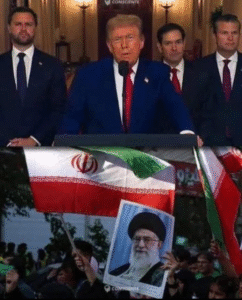There is currently no verified report confirming that Iran will strike America tonight or that any specific U.S. state is targeted. However, tensions between the United States and Iran have escalated significantly in recent days, prompting speculation and concern across diplomatic and military circles.
Let me walk you through the situation in depth, based on the latest intelligence and reporting:
🇮🇷 Rising Tensions: Iran and the United States
1. Military Movements and Speculation
On September 30, 2025, open-source flight trackers revealed a mass deployment of U.S. Air Force KC-135 Stratotankers toward Qatar. These refueling aircraft are critical for enabling long-range strike missions, especially involving stealth bombers like the B-2 Spirit and fighter jets like the F-22 Raptor. The scale and timing of this deployment—coinciding with a secretive military summit at Quantico—have fueled speculation that the U.S. may be preparing for a preemptive or retaliatory strike involving Iran.
While the Pentagon has not commented publicly, analysts suggest this could be a strategic positioning move in response to Iran’s recent hardline rhetoric and military posturing.
2. Iran’s Rejection of Diplomacy
On September 23, Iranian Supreme Leader Ali Khamenei categorically rejected all negotiations with the United States, marking a sharp departure from previous positions that allowed for indirect talks. He claimed that negotiations under threat would signal submission and embolden the U.S. to demand further concessions, such as halting Iran’s missile program and uranium enrichment.
This hardline stance came just months after the Israel-Iran War, which ended in June 2025. Khamenei emphasized Iran’s resilience and unity during that conflict, portraying the nation as defiant and prepared for further confrontation.
3. UN Sanctions Snapback
On September 27, the United Nations officially reimposed sanctions on Iran, citing “significant non-performance” of its nuclear commitments. These sanctions target Iran’s nuclear enrichment, ballistic missile development, and arms exports. The move was backed by France, Germany, and the UK, and signals a coordinated international effort to pressure Tehran.
The snapback sanctions include:
- Suspension of uranium enrichment and reprocessing
- Prohibition of ballistic missile technology
- Embargo on conventional arms exports
- Travel bans and asset freezes on key Iranian figures
This diplomatic escalation has further isolated Iran and may be contributing to its aggressive posture.
🧠 What Does This Mean for the U.S.?
Despite the alarming tone of some social media posts and rumors, there is no confirmed threat of an Iranian strike on U.S. soil tonight. The U.S. military’s movements appear to be precautionary and strategic, not reactive to an imminent attack.
However, the situation remains volatile. Here’s what experts are watching:
🔍 Key Indicators to Monitor
- Further troop or aircraft deployments to the Middle East
- Statements from CENTCOM or the Pentagon
- Iranian military exercises or missile tests
- Cybersecurity alerts targeting U.S. infrastructure
- Diplomatic communications from allies in the region
🛡️ Preparedness and Public Safety
If you’re concerned about national security, here are a few things to keep in mind:
- Stay informed through reputable news sources and government alerts.
- Avoid panic or spreading unverified claims—misinformation can cause unnecessary fear.
- Trust official channels like FEMA, DHS, and your state’s emergency management office for guidance.
🧭 Historical Context: Why This Matters
The U.S.-Iran relationship has been fraught with tension for decades, from the 1979 hostage crisis to the 2020 killing of General Qasem Soleimani. Nuclear negotiations, proxy conflicts in Syria and Iraq, and cyber warfare have all contributed to a complex and adversarial dynamic.
The current escalation is part of a broader geopolitical shift following the Israel-Iran War and the breakdown of nuclear diplomacy. Iran’s refusal to negotiate and the reimposition of sanctions have created a high-stakes environment where miscalculations could lead to conflict.
🧩 Conclusion
While there is no verified threat of an Iranian strike on the U.S. tonight, the geopolitical landscape is tense and evolving rapidly. The U.S. military is clearly preparing for contingencies, and Iran’s leadership is signaling defiance. This moment calls for vigilance, clarity, and calm—not panic.



